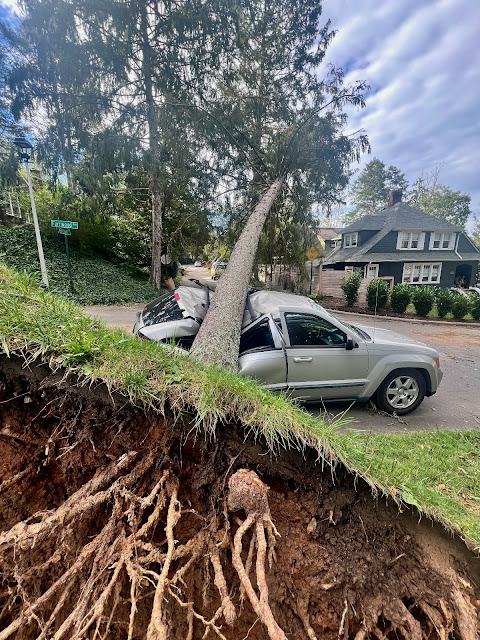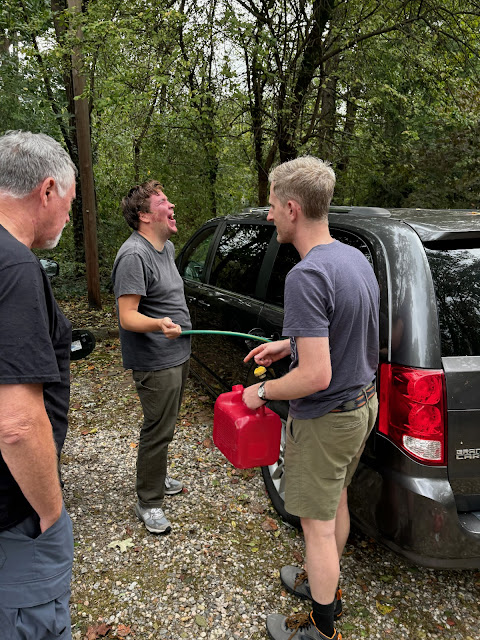Well, our family vacation did not go as expected — that would be an understatement.
.jpeg) |
| artwork by Hazel, age 5 |
Instead of hiking, foraging for mushrooms, dining at eclectic restaurants and enjoying the beautiful mountains of Western North Carolina, we spent the week dealing with the aftermath of Hurricane Helene that wreaked calamity on the town of Asheville and surrounding region.
By comparison with the residents of Asheville, we had it easy. Now back safely at Farm Dover, we can't stop thinking of the emotional and physical turmoil they have undergone and the long rebuilding process they are embarking on.
Here’s how it rolled out:
Ed, Jack and I arrived in Asheville, NC last Wednesday afternoon and unloaded our car at our beautiful airbnb, near downtown.
Jack then headed to the airport to pick up Mary and family, arriving from Brooklyn. That evening, it was pouring rain, so we ventured into town for dinner by car (making two trips as the six of us could not all fit in our Subaru.) Late that night, Maggie, Nate, Hazel and Norbert arrived from New Albany. We were thrilled to all be together: seven adults, two children and one very cute baby girl. Let the vacation begin!
The next day the rain continued. Not to be daunted by a few raindrops, we headed to nearby Hendersonville for a late breakfast and time at the children’s museum. We noticed that many of the shops had closed early because bad weather was predicted.
Once back in Asheville, Maggie and Nate went to the grocery for fixings for an at-home dinner. We stayed in for the night.
In the very early morning hours of Friday, remnants of Hurricane Helene blew through town. It rained hard. The wind blew. We could hear trees cracking and falling. We woke up to no electricity and only spotty cell service. By noon, our airbnb hosts were advising us to fill a tub with water as the city's water main (under the French Broad River) had broken, the river was flooding, and all city water would soon be turned off. We could no longer get any cell phone/internet service. It was eerily quiet except for the sound of chainsaws.
Brian and I headed out to fill up the car with gas. We only found stations that were unable to dispense gas without a generator or, long, long lines at the pumps of the only two stations that were open. We struck out. And still it rained.
On Saturday, without any intel on road conditions, we got on the road toward home, only to find all the gas stations closed and I-40 blocked by mudslides and washouts. While the rest of the gang drove back to our Airbnb, Ed, Jack and I waited at a Pilot station for 6 hours on the (false) belief that generators were on their way so the pumps could be turned on. We used the last of our gas to drive back to Asheville.
In the meantime, Brian and Nate had hiked to the a Harris-Tetter grocery, stood in line for two hours, and bought all the non-perishable provisions they could carry in bags and backpacks. We settled in with no electricity, no running water, no internet, no gas and no open highways. We did have a deck of “Go Fish.”
As we walked around the neighborhood, we were aghast at the number of fallen trees and damage to homes. Cars smashed beneath mighty oaks. We found a guy in a van with a Starlink connection and a willingness to let anyone use his cell service. Nate and Brian texted their parents to let them know they were alive and well. And Jack was able to connect with Kasia, who was in New York with her family from Poland.
Our airbnb hosts, Sarah and Doniel, were terrific. They brought over a gallon of gas and a fifth of Rye Whiskey — and checked on us often. We got to know the neighbors, the firemen at the local station, and Brian connected with a friend’s dad, who had a generator enabling him to recharge our phones, computers and external batteries for whenever we might get cell service.
Every hour, at the top of the hour, some of us would go sit in the van and tune into the local NPR radio station for updates. In the meantime, we played some rousing games of Sardines, read books to the kids, colored and made cootie-catchers. Hazel worked on documenting the trip for a school assignment and eight-month-old Roscoe Jane entertained us all with her smiles and hand-clapping.

Norbert and Hazel picked up all the fallen branches and sticks that had filled the front yard and they swept the porch. Maggie, Mary and I whipped up fairly imaginative meals from the ingredients we had on hand and which we served on paper plates. Nate and Brian captured rain water from the flooded basement to use to flush the toliets and figured out how to drain the hot water heaters for water to boil for drinking. We had nightly music with Nate on guitar and Jack on ukelele. Despite our predicament, we managed to have some lovely family time.


On Sunday, it became apparent that it would be days before we had any water, and gas still wasn’t available. On the plus side: we did get cell service. And with it, we were able to plan an exit toward home.
Our main barrier was the lack of gas in the Subaru. Nate and Brian worked on a solution most of Sunday afternoon. Syphoning gas from the Dodge van to the Subaru proved unsuccessful (as newer cars evidently have a screen that prevents it).
After some head scratching and trial and error, they figured out how to disconnect the fuel line at the engine of the van, jury rig it so that the fuel pump would run. With each turn of the key, they were able to get 5 ounces of gas. They worked at it until they captured 4 gallons which they transferred into the Subaru. Incredible brilliance and problem solving on display! Both cars could now be driven far enough to (hopefully) find a station where we could fill up.
And so it was that on Monday morning we pulled out of our Asheville drive, headed south toward Spartanburg, then east to Charlotte (on the only open highway) and then north to Beckley, WV and on toward Farm Dover. Twelve hours later, we were home. Tired and in need of a shower, but safe.
As we drove out of town, we were devastated by the water and wreckage. The town and outskirts along the river looked post-apocalyptic. Lives, businesses, and homes were lost. Trees were down everywhere. Water was everywhere it was not supposed to be. Western North Carolina is a beautiful place and will eventually heal from this devastation, but it will be a long, long time before life gets back to anything approaching normal.
___________________
Here is a list of lessons we learned; hope it helps you think about how you might prepare for a local disaster.
Now
- Purchase a hand-crank radio/phone charger.
- Put a flashlight and hand sanitizer in your car and in a designated place in your home.
- Keep extra batteries, a lighter or matches, and a stock of paper plates, cutlery and cups on hand.
- Purchase extra water in gallon containers; rotate to keep fresh.
- Purchase powdered or shelf-stable milk and non-perishable food items (peanut butter, mac and cheese, cans of tuna, pasta, etc.). Rotate on a regular basis.
- Have a first-aid kit, fully stocked.
- Keep prescriptions filled; purchase an extra pair of glasses or contact lenses.
- If appropriate, keep an emergency supply of diapers, formula, hygiene and sanitary products.
- Put all your important documents in one place. Make copies of your credit and identification cards.
- Consider keeping some emergency cash on hand.
- In cold weather, have blankets, hats, gloves, warm socks, etc. stored in one place.
- Don't toss your old technologies: Norbert's Paw Patrol walkie talkies, our old Garmin GPS, and car radio were each helpful to have. (Hazel boasted that her Etch-A-Sketch was the only working computer in the house!)
- Have a plan and communicate it to your loved ones.
When bad weather is predicted
- Fill vehicles with gas.
- Fully charge electronic devices
- Check in with your loved ones to remind them of your plan.
When bad weather/natural disaster happens
- Fill a bathtub with water (for flushing toilets)
- Shut off your water heater.
- Drain hot water tank for drinkable water (boil before drinking).
______________________
One last thought: if I had to be stranded with a group of people, there is no other group I’d rather be with. I heard no complaining; experienced only kindness; watched everyone step up and offer their expertise. Despite it all, we ready did have a lovely time together. These are my people — and I love them dearly.
















.jpeg)
















.jpeg)


















